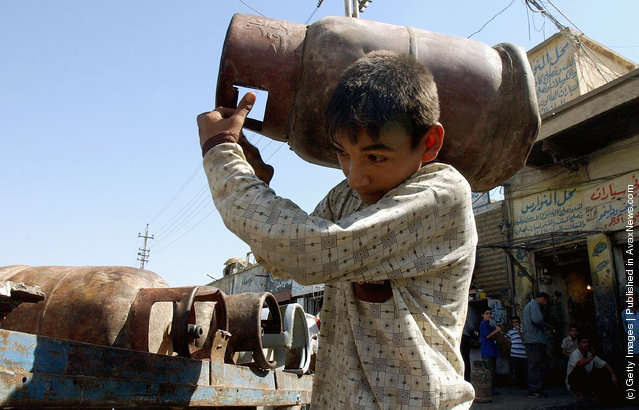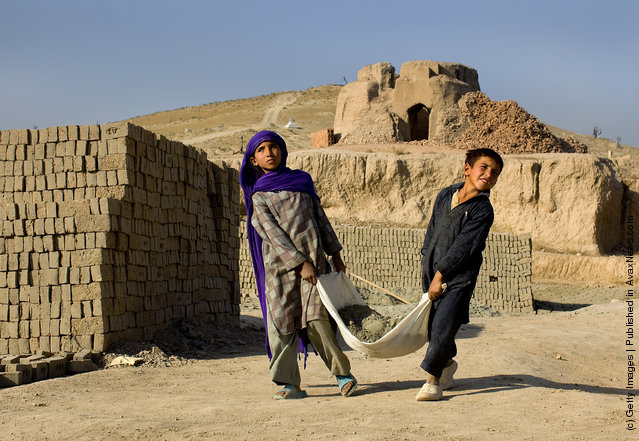

Children working in a clay pit to provide raw materials for a brick factory in Mexico City. (Photo by Central Press/Getty Images). 1970

Abdullah Sabah, 14, a school dropout, works in an automobile mechanic shop September 29, 2004 in Baghdad, Iraq. The boy will earn around six U.S. dollars a week for his work. War and poverty pushed large numbers of Iraqi children out of school and into work to support their families. (Photo by Wathiq Khuzaie/Getty Images)

Ali Fadhil, 11, a school dropout, works in an automobile mechanic shop September 29, 2004 in Baghdad, Iraq. (Photo by Wathiq Khuzaie/Getty Images)

Mustafa, 4, sits down as his father Muhammad Abdulbakil works in an automobile mechanic shop September 29, 2004 in Baghdad, Iraq. Muhammad says that he brings his son to the shop so he can take over the profession when he grows up. (Photo by Wathiq Khuzaie/Getty Images)

Muhammad Latif, 13, a school dropout, works in an automobile mechanic shop September 29, 2004 in Baghdad, Iraq. (Photo by Wathiq Khuzaie/Getty Images)

Heider Karim, 14, carries a propane gas tank September 29, 2004 in Baghdad, Iraq. (Photo by Wathiq Khuzaie/Getty Images)

A child helps scavenge at the large Bantargebang rubbish dump in Bekasi on February 17, 2007 near Jakarta, Indonesia. Hundreds of Indonesians risk disease and other dangers in their struggle to find items to sell to dealers, from whom they can expect to earn in the region of 25,000 Indonesian Rupiah (USD2.80) a day. In September 2006, the tip collapsed killing 3 scavengers. Over 6,000 Tons of waste is dumped daily at what is Jakarta's principal land-fill site. (Photo by Dimas Ardian/Getty Images)

A young boy sells documentary photos of the earthquake at the old town area which was devastated in the May 12 Sichuan Earthquake and is now trying to get a UNESCO world cultural heritage status as an earthquake relic site on November 27, 2008 in Beichuan County, Sichuan Province, China. (Photo by China Photos/Getty Images)

Gulseema aged 5, holds her shovel as she works at the Sadat Ltd. brick factory on November 6, 2009 in Kabul, Afghanistan. Child labour is common at the brick factories where the parents work as labourers, desperate to make more money enlisting their children to help doing the easy jobs. Brick factories are an economical, business that is still thriving. The land used is dry and barren which is perfect for the making of bricks providing work almost all the year round. A few years ago all factories changed from wood to coal causing further problems with pollution, the factories have been pushed out of the city limits because of this issue. Workers can make an average of USD 200 to 300 per month. For 1,000 bricks the factory will get about USD 45. (Photo by Paula Bronstein/Getty Images)

Salma aged 9, sorts bricks at the Sadat Ltd. Brick factory where she works from 8am to 5 pm daily to help support her family on November 4, 2009 in Kabul, Afghanistan. (Photo by Paula Bronstein/Getty Images)

Shajakhan, 8, and her brother Noor Agha use brick molds to make bricks by hand with clay on October 16, 2009 in Kabul, Afghanistan. (Photo by Paula Bronstein/Getty Images)

An Afghan boy works with other young laborers loading bricks onto a truck on October 16, 2009 in Kabul, Afghanistan. (Photo by Paula Bronstein/Getty Images)

Shajakhan, 8, and her brother Sahjerkhan,6, carry a heavy bag of clay to make bricks on October 16, 2009 in Kabul, Afghanistan. (Photo by Paula Bronstein/Getty Images)

Roman aged 7, sorts bricks at the Sadat Ltd. Brick factory where he works from 8am to 5 pm daily on November 4, 2009 in Kabul, Afghanistan. (Photo by Paula Bronstein/Getty Images)





Indian children work nearby to their parents at a construction project in front of the Jawaharlal Nehru Stadium on January 30, 2010 in New Delhi, India. The children accompany their parents to the work site, where if they are prepared to work, they will receive money for bread an milk and be provided with dinner by the contractor. The sheer scale of the project has drawn an enormous population of migrant workers from all over India.





Afghan children sorts bricks at the Sadat Ltd. Brick factory, where they work from 8am to 5 pm daily, on May 14, 2010 in Kabul, Afghanistan. (Photo by Majid Saeedi/Getty Images)

An Afghan child carries shovels at the Sadat Ltd. Brick factory, where some children work from 8am to 5 pm daily, on May 14, 2010 in Kabul, Afghanistan. (Photo by Majid Saeedi/Getty Images)

An Afghan child shovels sand at the Sadat Ltd. Brick factory, where some children work from 8am to 5 pm daily, on May 14, 2010 in Kabul, Afghanistan. (Photo by Majid Saeedi/Getty Images)

An Afghan child transports bricks at the Sadat Ltd. Brick factory, where he works from 8am to 5 pm daily, on May 14, 2010 in Kabul, Afghanistan. (Photo by Majid Saeedi/Getty Images)

A child lifts bricks as other Afghan labourers work at a brick-making kiln on October 12, 2010 in the countryside outside Herat in western Afghanistan. Labourers earn very little in a ten hour day at the kiln. The majority of brick-makers are internal refugees displaced from their provinces after insurgencies. Child labour is common in brick-making facilities where parents use their children to assist with easier jobs. (Photo by Majid Saeedi/Getty Images)
20 May 2011 07:00:00,
post received
0 comments
